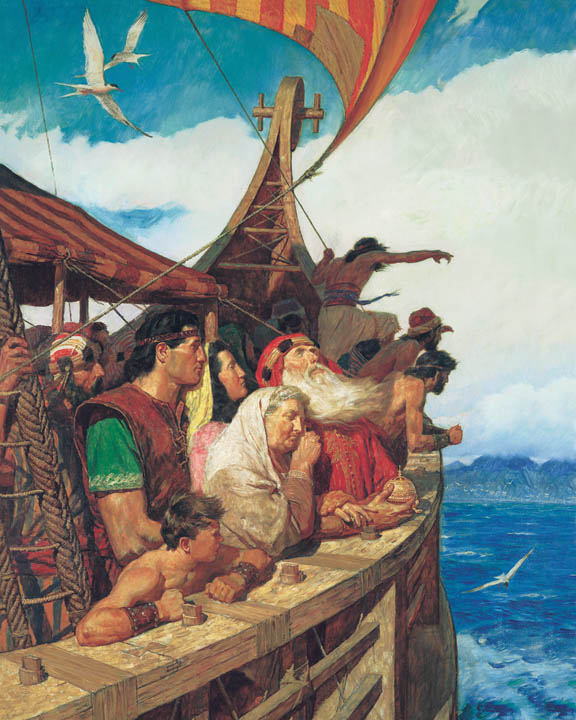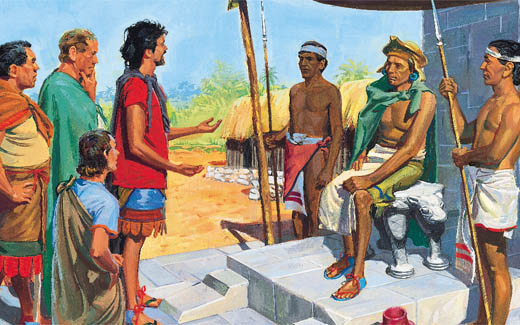By Gerald Smith
Pronounced: Lee Hai
Basic bio:
Lehi was a descendant of Manasseh, the son of Joseph. Around 600 BC, “in the commencement of the first year of the reign of Zedekiah, king of Judah” (1 Nephi 1:4), he dwelt in or near the city of Jerusalem. During the Assyrian destruction of the Northern Kingdom of Israel in 721 BC, many people from the tribe of Joseph fled to Jerusalem to escape the destruction. Presumably, this included Lehi’s ancestors (1 Chronicles 9:3, 2 Chronicles 30:1-11).
 Religious and political traditions from the Northern Kingdom differed from the Kingdom of Judah. Around the year 600 BC, the Lord called Lehi as a prophet, to call Jerusalem to repentance. Along with the prophet Jeremiah and other s, Lehi condemned the wicked works of the leaders of Israel, as well as their corrupted temple ordinances. The people were angered by the prophets. Jeremiah was imprisoned, and Lehi’s life was threatened. The Lord led Lehi and his family out of Jerusalem, promising to take them to a new land of promise.
Religious and political traditions from the Northern Kingdom differed from the Kingdom of Judah. Around the year 600 BC, the Lord called Lehi as a prophet, to call Jerusalem to repentance. Along with the prophet Jeremiah and other s, Lehi condemned the wicked works of the leaders of Israel, as well as their corrupted temple ordinances. The people were angered by the prophets. Jeremiah was imprisoned, and Lehi’s life was threatened. The Lord led Lehi and his family out of Jerusalem, promising to take them to a new land of promise.
Their journey in the wilderness, lasting approximately eight years, probably followed the ancient Spice Trade route, southward along the Red Sea. After three days of travel, Lehi and his family made their first encampment in a narrow valley he called Lemuel. From there, the Lord commanded Lehi to send his sons, Laman, Lemuel, Nephi and Sam, back to Jerusalem to obtain the Brass Plates of Laban, which contained the genealogy of the tribe of Manasseh, as well as the Northern Kingdom’s sacred scriptures (and recent prophecies of Jeremiah and other prophets in Jerusalem). He later sent his sons to invite Ishmael and his family to join them, providing Ishmael’s daughters as wives to Lehi’s sons.
Lehi discusses major dreams and visions with his family (see below), which helps him determine that his youngest son, Nephi, should be his heir apparent as first born, and the future religious leader of the people. One morning, as Lehi left his tent, he discovered a strange device, known as the Liahona. This device was similar to a compass or GPS unit that worked on the faith and righteousness of the family. The wording on the Liahona would occasionally change to give them additional instructions. With the Liahona, the group continued southward along the Spice Trade route until reaching the area called Nahom in south-western Arabia. From there, the family turned eastward until reaching the ocean shore in modern Oman.
During the journey, Lehi and his wife, Sariah, had two more sons, Jacob and Joseph. The expanded family built a ship under the Lord’s guidance, and traversed the ocean. During the ocean voyage, Lehi and Sariah fell ill. During this period, Laman, Lemuel, and several others began riotous partying. Nephi was bound, and the rest were powerless to stop the sinful actions going on. A major storm arose, beating the ship for four days, until the rebellious sons humbled themselves and loosed Nephi. During this time, Lehi seemed to be on his deathbed with illness, but did recover. Eventually, Lehi and his family arrived on the western coast of the Americas, probably somewhere in Mesoamerica.
In his last days, Lehi called his family together. He encouraged Laman, Lemuel, and the sons of Ishmael to embrace the Lord and accept Nephi as their leader. Lehi gave major discourses to his sons Jacob and Joseph. To Jacob, he explained the plan of salvation, the need for opposition in all things, and how Christ’s atonement frees us from sin and death (2 Nephi 2). Lehi taught Joseph that he was named after the great patriarch who saved the 12 tribes of Israel. He mentions a prophecy from ancient Joseph regarding Moses and a prophet in the last days, who would also be named Joseph, who would restore many precious things to the tribe of Joseph, Israel, and the world.
Soon afterward, Lehi died and was buried.
Key spiritual concepts we learn from Lehi
In 1 Nephi 1, we learn from Nephi that he was raised by “goodly parents.” The first chapter describes Lehi’s first visions and his prophetic calling. In his first vision, he sees a pillar of fire and “saw and heard much” that caused him to tremble exceedingly. This vision left him without strength, so he went home and laid down to rest. No sooner had he done this, when he was carried off in vision. In this vision, he saw the heavens open and saw God on his throne, surrounded by angels singing praises to God. Angels descend from heaven, and one gives him a book to read. Upon reading the book, Lehi is given the ability to also praise God with the tongue of angels. As with the prophet Isaiah, Lehi stood before God’s throne and was given the ability to speak with the angels and God (Isa 6), being invited into the divine council of God. This concept of entering into God’s presence and being a part of the angelic council of God will be a main teaching throughout the Book of Mormon, beginning with the first chapter and Lehi.
During the journey, we find that Lehi “dwelt in a tent” and sacrificed on altars in the wilderness. Combined with his visions above, Lehi becomes a symbolic Moses for his family. Moses built a Tabernacle or Tent of God’s Presence. Lehi’s tent became the focal point of councils with his family (symbolizing the divine council), as well as the place of being in God’s presence (via his vision). As with Moses, Lehi leads his people in the wilderness, receives the Law and commandments (Brass Plates of Laban), manages the rebellion of some of the people, and finally brings them to the Promised Land. Prior to death, both Moses (Deuteronomy 28-34) and Lehi (2 Nephi 2-4)) leave their people with a blessing and teaching that if they are obedient they will be blessed and brought into God’s presence, but if they disobey will be chastised, destroyed, and cast out of God’s presence (symbolized by the land of Promise).
In his Vision of the Tree of Life (1 Nephi 8-10), Lehi is taken through an ancient ritual journey that has the pattern of Creation, Fall, Atonement, Covenant, and Returning to the Presence of the Lord. An angel leads him through darkness, which represents the chaos of the Creation of the world. Upon praying for help, the darkness leaves and he sees the created world around him. It is represented by several symbolic things: a great and spacious building that represents the pride of the world and its Fall. A river of filth in which people fall into by wandering in strange paths. Mists of darkness that weave around those strange paths. Then we see a straight path or staircase, with an iron bannister (representing God’s word) leading to the Tree of Life. The Tree is exceedingly white, with a white fruit, whose taste is exquisite and fills one with true joy. Lehi (and later Nephi when he also has a similar vision in 2 Nephi 11-15) learn that the fruit of the Tree is Jesus Christ, who sheds his love and salvation on all who will partake, symbolizing the Holy Supper that Jesus would institute in his mortal life. Again, we see an ascension to God, similar to Jacob’s ladder or staircase into heaven (Genesis 28).
We learn from Lehi’s visions that life is symbolic and can follow the experience of the ancient prophets Adam, Moses, and of our Lord Jesus Christ. In following him, we experience our own creation, fall (through our sins), our atonement through Christ’s grace, our making of covenants and ordinances with God as a symbol of embracing Christ, and our eventual return into God’s presence. As noted, this pattern will occur often in the teachings of the Book of Mormon, and is perhaps one of its most important teachings to us this day.
Source:
Every Person in the Book of Mormon by Lynn F. Price; Horizon Publishers
http://youtu.be/YIWDzZ6GiSM
Additional Resources:
The Book of Mormon (Another Testament of Jesus Christ)





Recent Comments